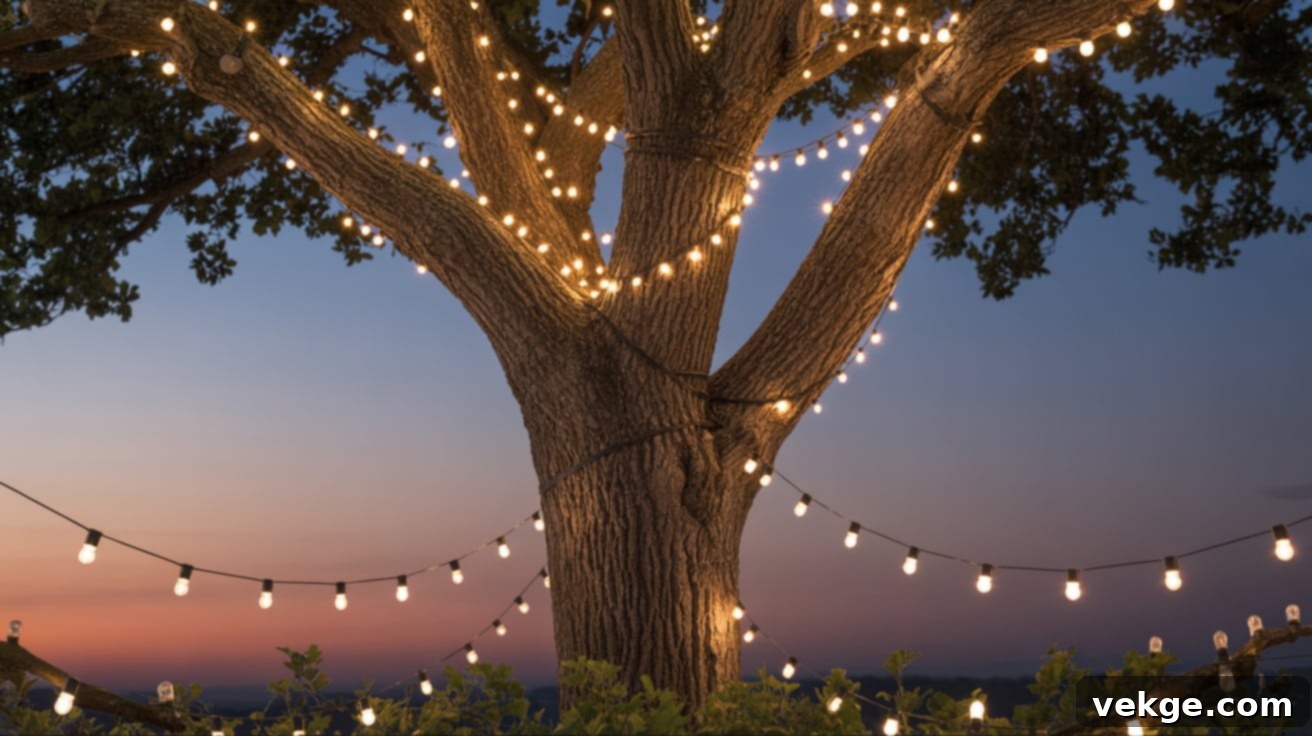The Ultimate Guide to Hanging Beautiful String Lights in Trees for Stunning Outdoor Ambiance
Imagine your backyard bathed in a soft, enchanting glow, where the trees come alive with twinkling lights, creating an atmosphere straight out of a fairy tale. A yard full of softly lit trees can truly transform the entire feel of your outdoor space, turning it into an inviting haven for relaxation, entertainment, or quiet contemplation. Adding string lights to your trees is not only one of the simplest but also one of the most impactful ways to elevate your outdoor aesthetic and create a truly magical ambiance.
This comprehensive guide will walk you through everything you need to know about incorporating string lights into your tree-lined landscape. We’ll cover how to select the perfect lights that suit your needs and style, demonstrate safe and effective methods for hanging them without harming your precious trees, and offer creative styling tips for various events and seasons. You’ll also discover essential safety precautions and innovative ideas to enjoy your illuminated trees throughout the year. Are you ready to make your yard feel like a truly special place after dark? Let’s dive into the world of tree string lights and illuminate your outdoor living!
Why String Lights in Trees Create Such a Special Outdoor Atmosphere
String lights woven through tree branches do more than just provide illumination; they craft a warm, welcoming, and intimate atmosphere that enhances any outdoor setting. Whether you’re aiming for a casual everyday vibe or preparing for a significant celebration, these lights introduce a soft, diffused glow that makes outdoor areas incredibly inviting without being overly bright or harsh. This gentle illumination can completely change the perception of your garden, patio, or deck, turning mundane spaces into memorable ones.
Perfect for a relaxed backyard dinner under the stars, a festive holiday gathering, or simply unwinding after a long day, string lights allow your trees to become natural focal points. Their versatility makes them suitable year-round, from balmy summer evenings that invite lingering conversations to cozy winter gatherings that benefit from a touch of warmth. They seamlessly integrate with various design aesthetics, from rustic to modern, providing both beauty and functionality in a single, captivating setup. You can arrange them for an effortlessly charming look on a casual night or shape them into more structured, intricate displays for parties, weddings, or seasonal décor. With thoughtful placement, string lights can elegantly highlight the unique architecture of tree branches, subtly guide footpaths, and draw attention to open areas, creating depth and visual interest in your landscape.
Essential String Light Types for Outdoor Tree Lighting
Selecting the ideal string lights for your trees is crucial and depends on several factors: your specific setup requirements, the local weather conditions, and how long you intend for them to be installed. Beyond aesthetics, you’ll need to consider practical elements such as power sources, vital safety features, and the appropriate size or style of bulbs that best complement your outdoor space and design vision.
LED and Incandescent String Lights: A Comparison
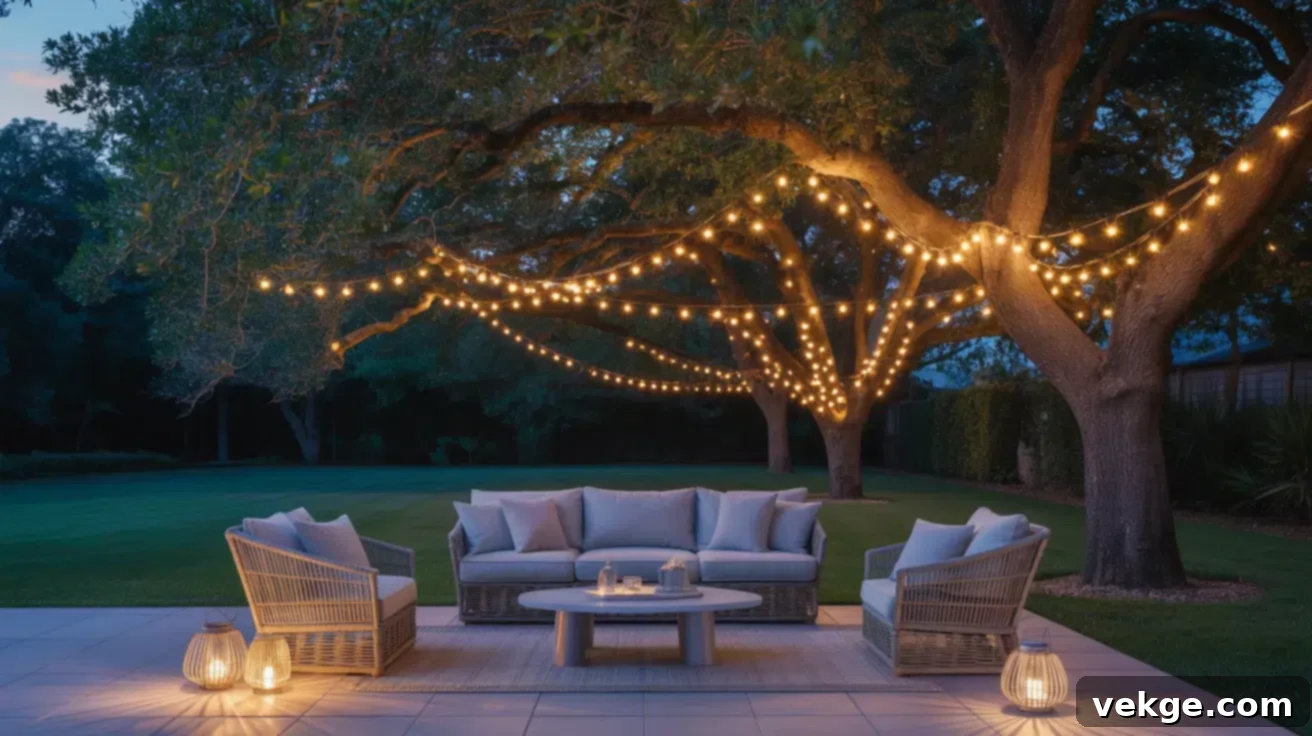
When it comes to bulb technology, the primary choices are LED (Light Emitting Diode) and incandescent lights. **LED lights** are a modern marvel, renowned for their energy efficiency and exceptional longevity. They consume significantly less electricity than their incandescent counterparts, translating into lower energy bills and a smaller environmental footprint. Furthermore, LED bulbs generate very little heat, making them a safer option for outdoor use, especially when in proximity to natural elements like tree foliage. Their durability means they can withstand frequent use and extended periods of illumination without burning out quickly. For most tree lighting applications, particularly those intended for long-term or frequent use, LED options are almost always the more practical and safer choice due to their cool operation and robust nature.
**Incandescent lights**, on the other hand, offer a classic, warm, and nostalgic glow that many find appealing. This traditional warmth is a result of a filament heating up, which also means they consume more power and tend to burn out much faster than LEDs. While they provide a charming, soft light, their higher energy consumption and shorter lifespan make them less ideal for extensive or long-duration outdoor installations where practicality and efficiency are key considerations. They also produce more heat, which can be a minor concern when wrapped closely around tree branches.
Solar, Battery, and Plug-in String Lights: Powering Your Display
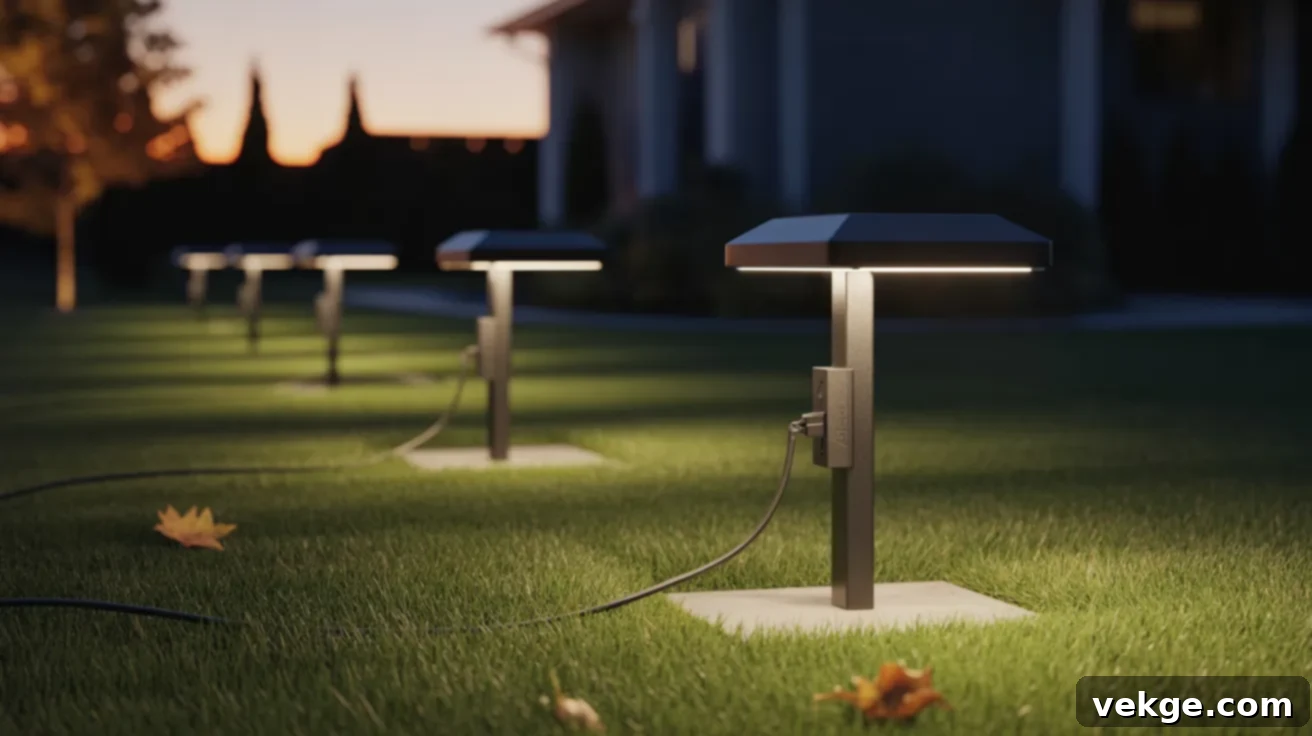
The method you choose to power your string lights dictates their placement flexibility and maintenance. **Solar-powered lights** are an excellent eco-friendly option, charging during the day via a small solar panel and automatically illuminating at night. They offer unparalleled flexibility as they require no external wiring or outlets, making them perfect for remote areas of your yard. However, their brightness can vary depending on sun exposure; they may dim or last shorter durations during cloudy weather or in heavily shaded areas. **Battery-powered lights** provide similar installation ease and portability, allowing you to place them almost anywhere. The trade-off, however, is the need for frequent battery changes, which can become costly and inconvenient over time, especially for large displays.
**Plug-in lights** offer the most consistent and brightest illumination. They draw power directly from an electrical outlet, ensuring reliable performance regardless of sunlight or battery life. The main requirement for plug-in lights is proximity to an outdoor-rated power source, which might necessitate the use of outdoor extension cords. When choosing, consider how often you’ll use the lights, the accessibility of outdoor power outlets, and your preference for setup convenience versus consistent brightness.
Waterproof and Outdoor-Rated Options: Durability and Safety
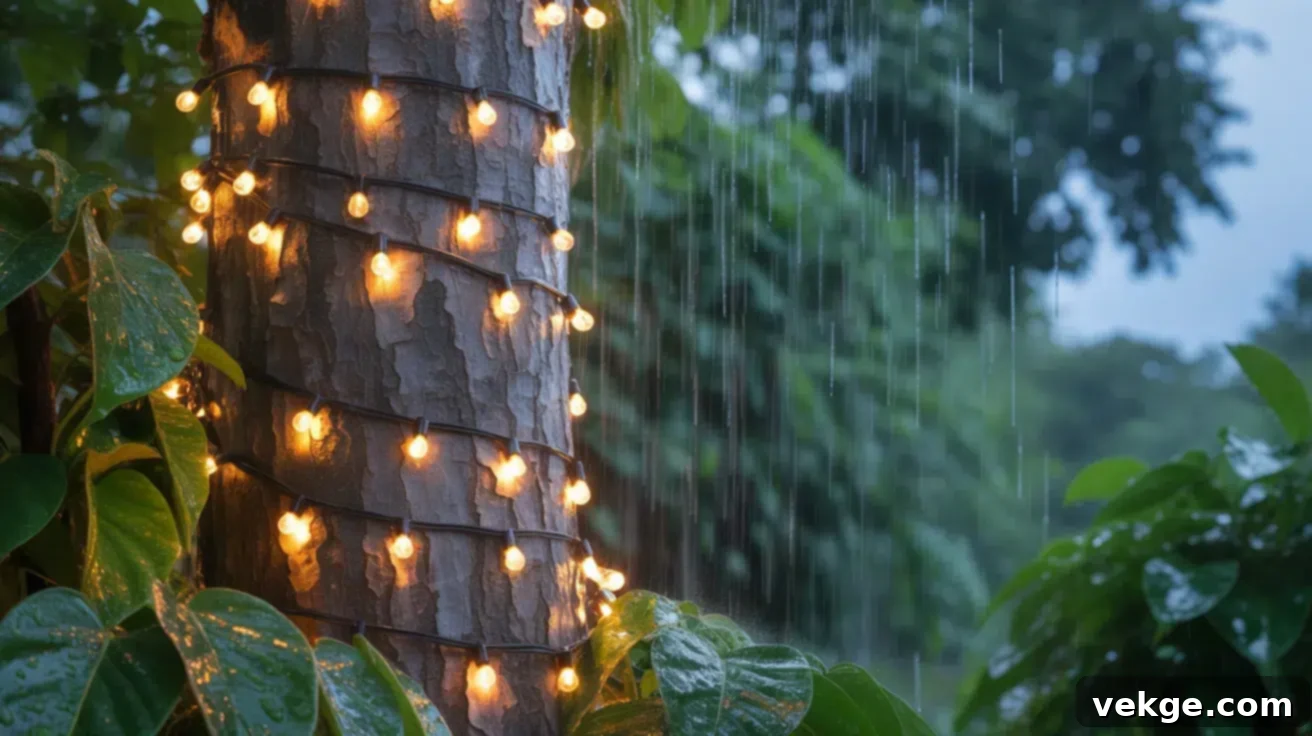
For any outdoor lighting installation, safety and longevity are paramount. Always insist on purchasing string lights explicitly labeled for outdoor use. These lights are engineered to withstand the elements. Look for specific waterproof ratings, such as **IP65 or higher**, which indicate robust protection against rain, splashes, dust, and other environmental factors. An IP65 rating means the lights are dust-tight and protected against low-pressure water jets from any direction, making them suitable for most outdoor weather conditions.
Additionally, ensure that the cords and sockets are outdoor-rated. These components are specially manufactured to resist damage from moisture, UV radiation, and temperature fluctuations, which are common in outdoor environments. Using properly rated lights and cords not only extends the lifespan of your beautiful display but also significantly enhances safety, preventing electrical hazards, especially during wet or cold seasons. Investing in quality outdoor-rated lights will save you from frequent replacements and potential safety issues down the line.
Picking the Right String Light Size and Style for Your Trees

The visual impact of your tree lighting display heavily relies on choosing the appropriate string light size and style. First, determine the necessary length of your light strands based on your tree’s height, its canopy spread, and the desired coverage. Will you be wrapping the trunk, draping branches, or creating a canopy between multiple trees? Measuring accurately will prevent you from having too many or too few lights, ensuring a balanced and complete look.
Bulbs come in a delightful array of shapes and sizes, each contributing a unique aesthetic. Common options include charming **globe bulbs** (often C7 or G40), tiny and delicate **mini bulbs** (fairy lights), and elegant **teardrop shapes**. Smaller bulbs, like mini lights, are perfect for adding subtle detail, creating a delicate twinkle, or highlighting intricate branch patterns without overwhelming the tree. They are excellent for a denser, more uniform glow. Larger bulbs, such as globe or Edison-style bulbs, emit a stronger, more pronounced light and are ideal for making a bold statement, illuminating larger areas, or creating a festive, bistro-like atmosphere.
Consider the overall appearance you wish to achieve. Mixing different shapes or sizes can introduce rich texture and dynamic visual interest, while sticking to a single style can create a cohesive and sophisticated presentation. For instance, large globe lights might define the main canopy, while smaller fairy lights could be used to wrap thinner branches or create a sparkling accent. Remember that the choice of bulb style can dramatically alter the setup’s appearance, both up close and from a distance, so visualize your desired outcome before making your selection.
How to Hang String Lights in Trees: A Step-by-Step Safe Guide
Hanging string lights in trees might seem like a daunting task, but with a little planning and careful execution, it’s a straightforward process. This step-by-step guide is designed to help you install your lights safely, protect the health of your trees, and create a stunning display that looks fantastic from every angle. Following these instructions will ensure a durable and beautiful installation.
Step 1: Plan Your Setup and Visualize the Design
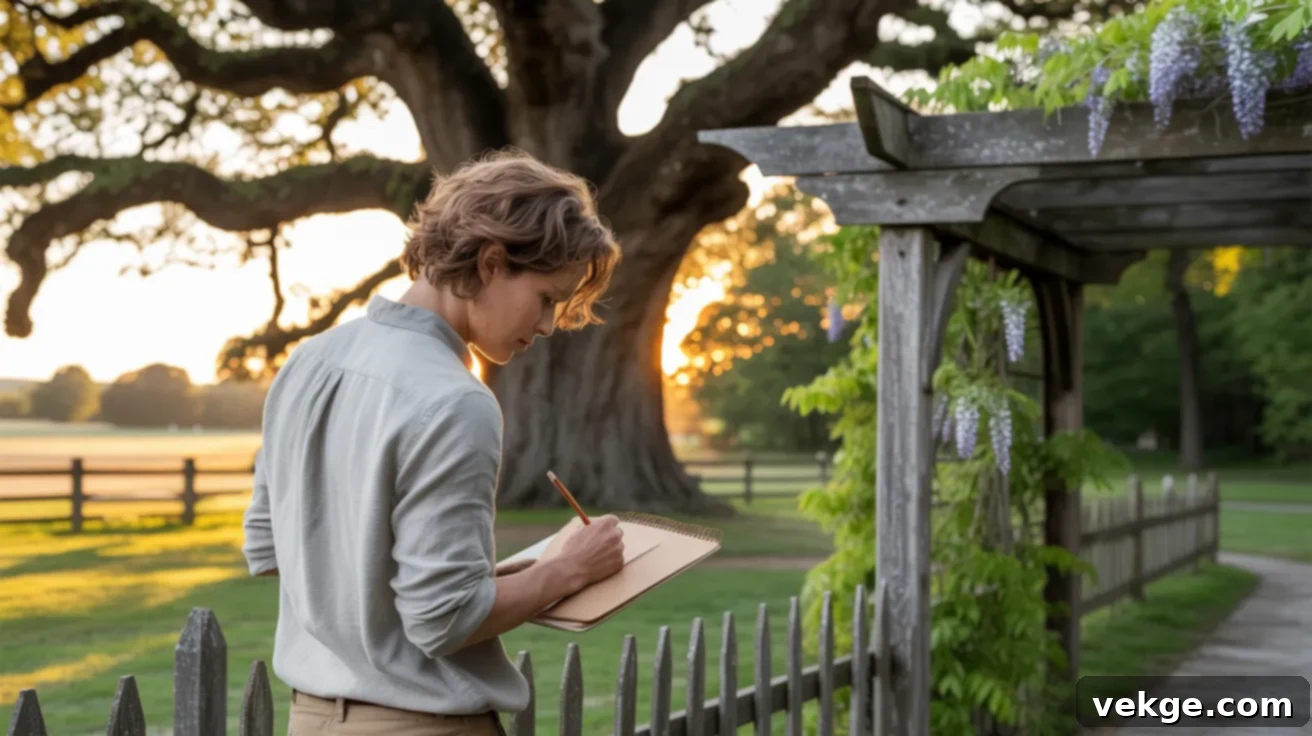
Before you even unbox your lights, take a deliberate walk around your tree. Observe its unique characteristics: identify strong, sturdy branches capable of supporting the lights, note the height of the trunk, and assess the available space around the tree. This initial reconnaissance is crucial for planning. Envision where the lights will look most effective: will they elegantly drape across larger branches, spiral up the trunk, or stretch gracefully to nearby supports like a pergola, fence, or garden wall? Consider the tree’s natural shape and how the lights can enhance it. I often find it helpful to sketch out my design ideas on paper first. This allows me to experiment with different layouts, anticipate challenges, and ensure I don’t miss any crucial details during the actual setup.
Step 2: Measure the Area Accurately
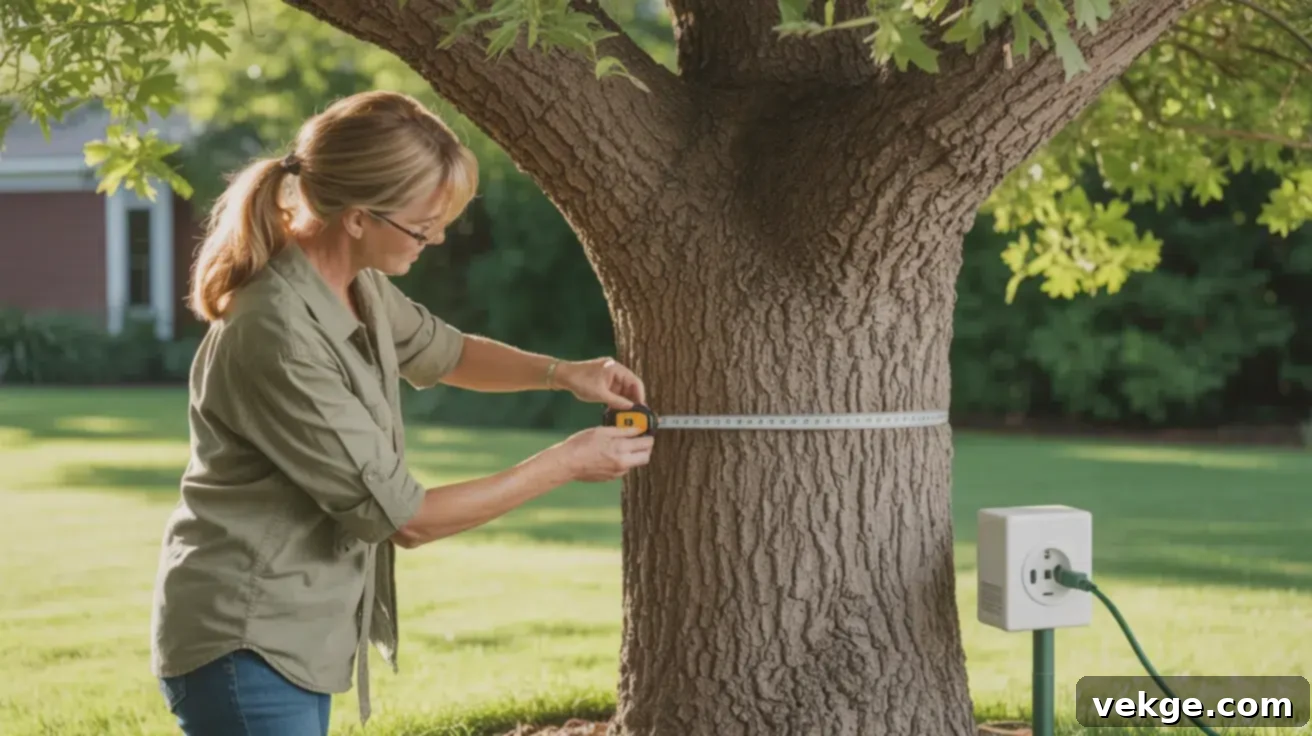
Once you have a clear vision, it’s time to measure. Use a flexible measuring tape or a piece of string to accurately map out the exact path where your lights will be placed. I prefer to start measuring from the nearest power source and follow the planned layout, accounting for every curve and drop. You’ll need to measure the lengths across branches, around the circumference of the trunk, and the distances between trees if you’re creating a captivating light canopy. Don’t forget to measure the drop for any hanging elements. Accurate measurements are vital; they help you purchase the correct amount of lights, prevent unsightly sagging, and ensure you don’t overstretch the strands once everything is meticulously in place. It’s always better to have a little extra length than to come up short.
Step 3: Choose Safe Anchors and Fasteners
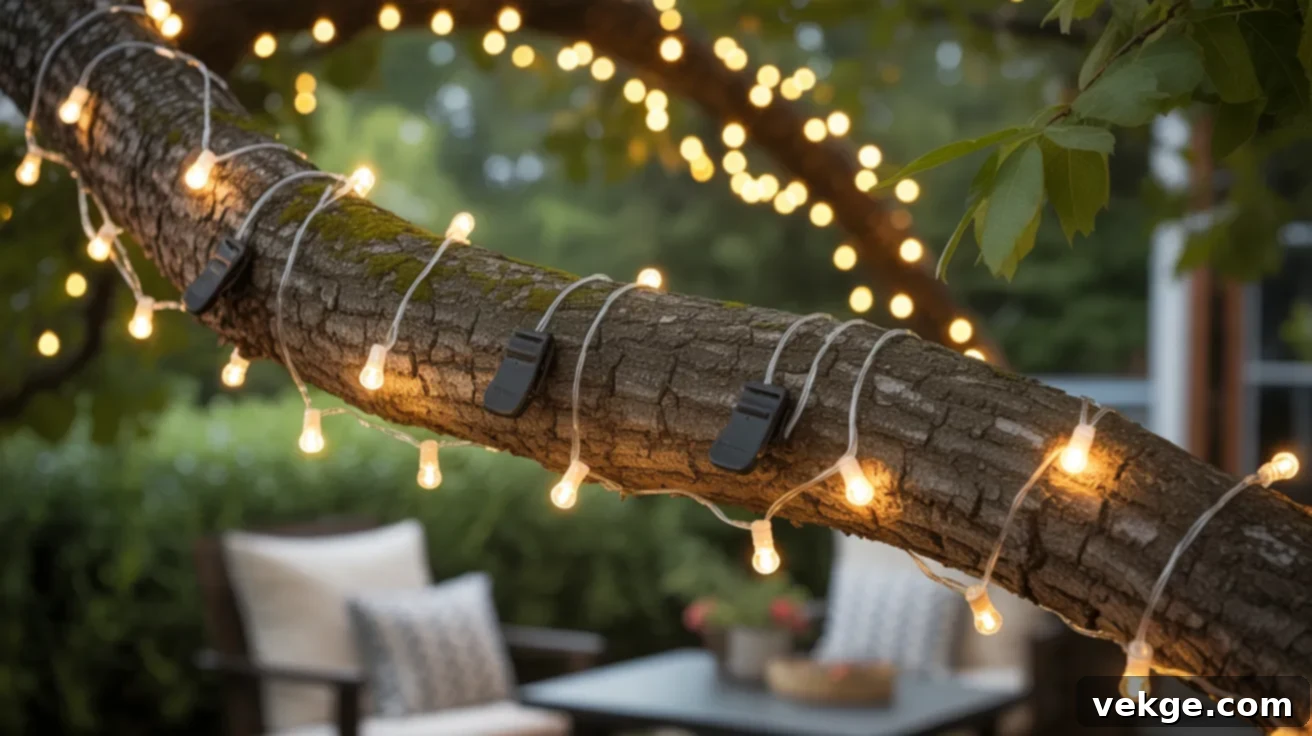
This is a critical step for both the longevity of your display and the health of your trees. Avoid using nails, screws, or staples directly into the tree bark, as these can cause long-term damage, inhibit growth, and create entry points for pests or diseases. Instead, always opt for safer alternatives that will not harm the tree. Excellent choices include **outdoor light clips** specifically designed to snap onto branches without constriction. **Soft twist ties**, **Velcro straps**, or even natural jute twine offer flexible yet secure holds that won’t dig into the bark. If you use **zip ties**, ensure they are not pulled too tightly; leave some slack to allow for tree growth and movement. For larger setups or to provide extra support for heavier strands, **bungee cords with hooks** can be a great, tree-friendly option. Experiment with a few different methods to find what provides the best hold and aesthetic for your particular tree and light strands.
Step 4: Wrap or Drape Lights Gently and Strategically
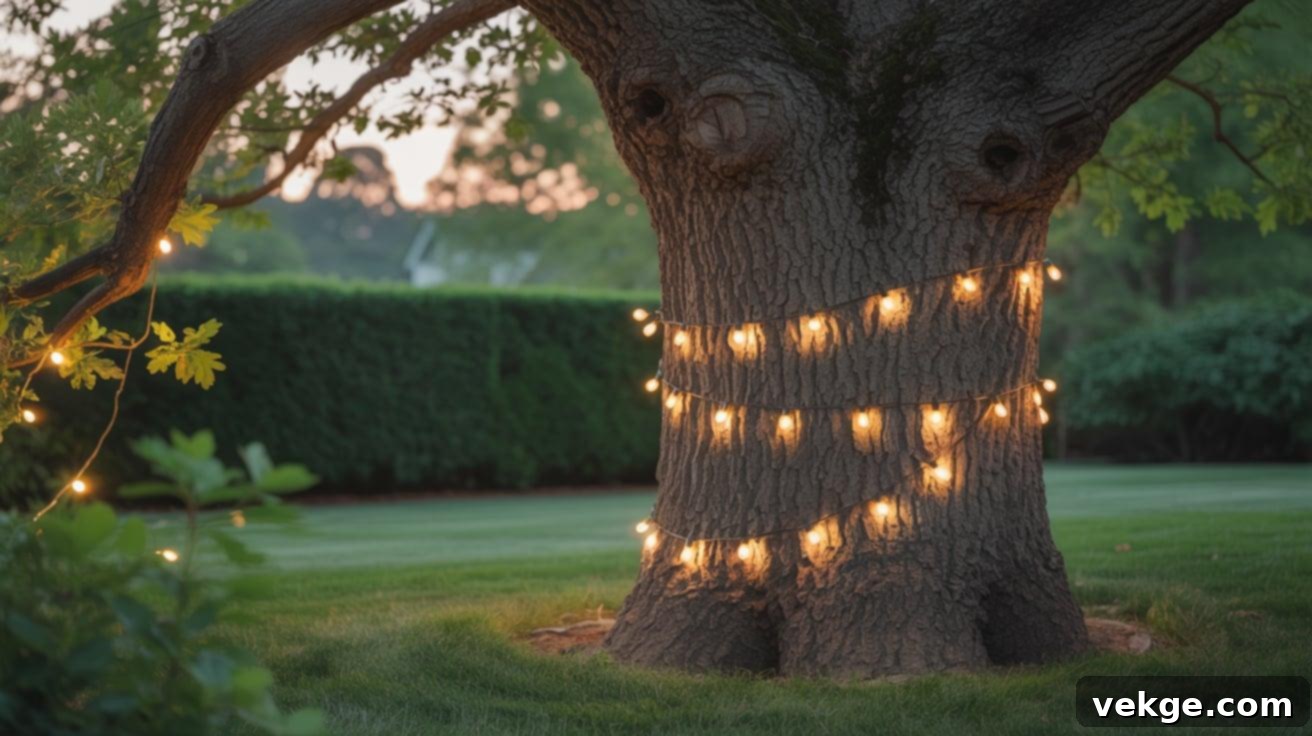
Begin wrapping string lights around the trunk or major branches with a light, even tension. The goal is to hold them securely in place without pulling too tightly or constricting the tree’s growth. If you are draping lights, ensure they are supported every few feet using your chosen clips, soft ties, or straps to prevent sagging and maintain an elegant line. It’s essential to leave a small amount of slack in the wraps and drapes; this accommodates the natural growth of the tree and prevents the lights from digging into or girdling the bark over time. For long-term installations, I recommend checking the setup every few weeks or seasonally to ensure nothing has shifted, tightened, or become dislodged. This proactive approach keeps your display looking neat and protects the tree’s health as it continues to grow and flourish.
Step 5: Utilize Poles or Posts for Additional Support
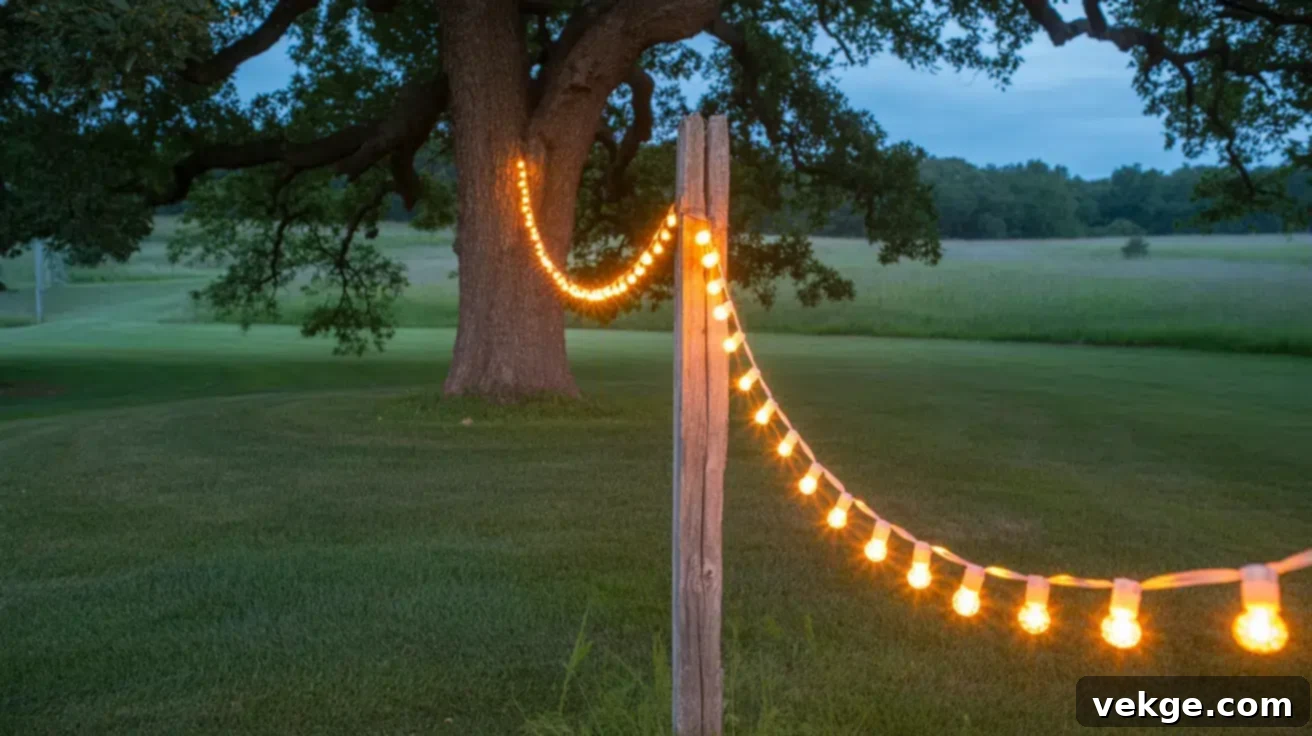
Sometimes, a single tree or its existing branches aren’t sufficient to achieve the desired lighting design, especially for expansive displays or overhead canopies. In such cases, incorporating auxiliary poles or posts can provide much-needed support. These can be simple wooden stakes, sturdy metal rods, or even existing fence posts. To use them, simply attach an outdoor-rated hook or screw eye near the top of the pole. You can then run your light strands from this anchor point to the tree, or between multiple poles and trees. This technique grants you greater control over the spacing and height of your lights, ensuring everything remains steady and taut. It’s particularly effective for illuminating larger areas, creating a captivating overhead effect in wide-open yards, or extending light to areas where branches aren’t available.
Step 6: Secure the Ends and Ensure Stability
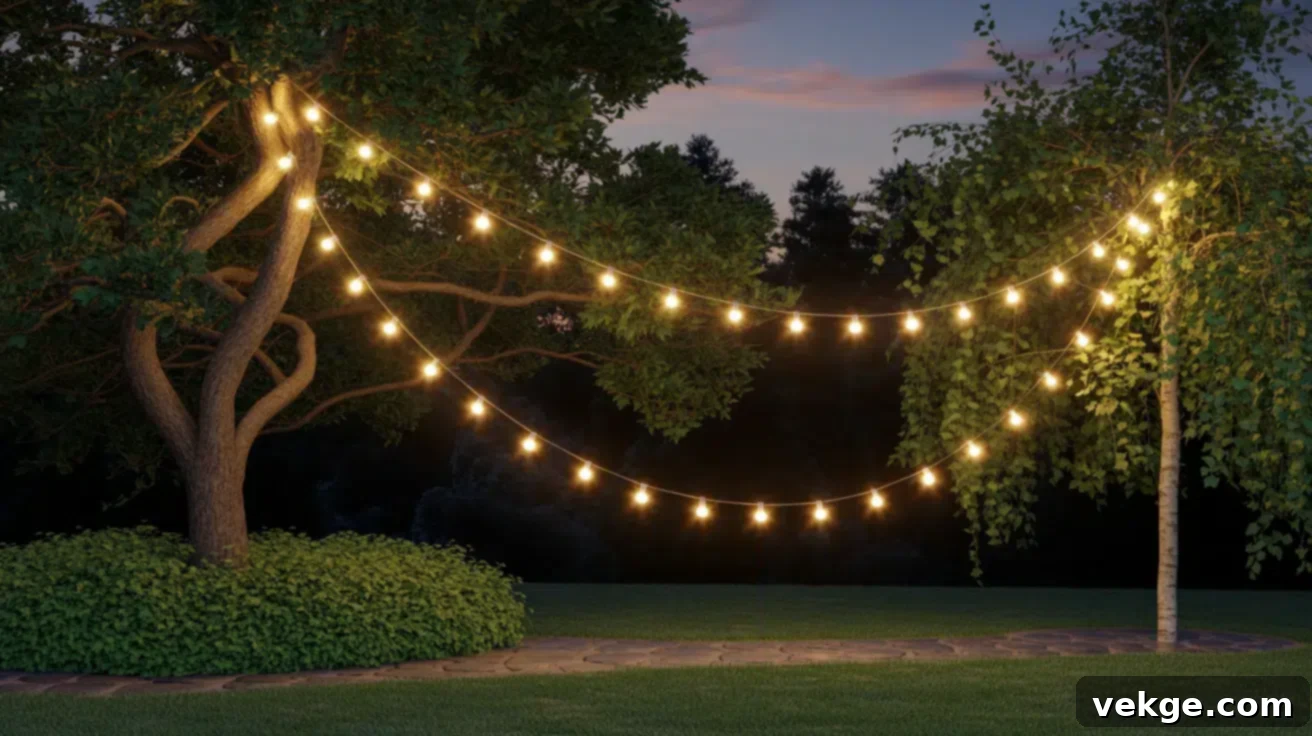
Once your lights are draped or wrapped, it’s crucial to firmly attach the end of each light strand to its designated support point using a robust clip, hook, or strap. Don’t underestimate this simple step; it’s vital for the integrity of your entire display. I always perform a double-check to ensure that every connection point is stable and secure, particularly if the lights span a wide area or involve multiple trees. If you’re running lights between trees or poles, make sure to add intermediate support points along the way. This helps to distribute the weight evenly, preventing unsightly drooping and significantly reducing the risk of the lights pulling loose during windy conditions, heavy rain, or other weather changes. A properly secured setup will withstand the elements and maintain its beautiful appearance for longer.
Step 7: Test the Lights and Fine-Tune Your Display
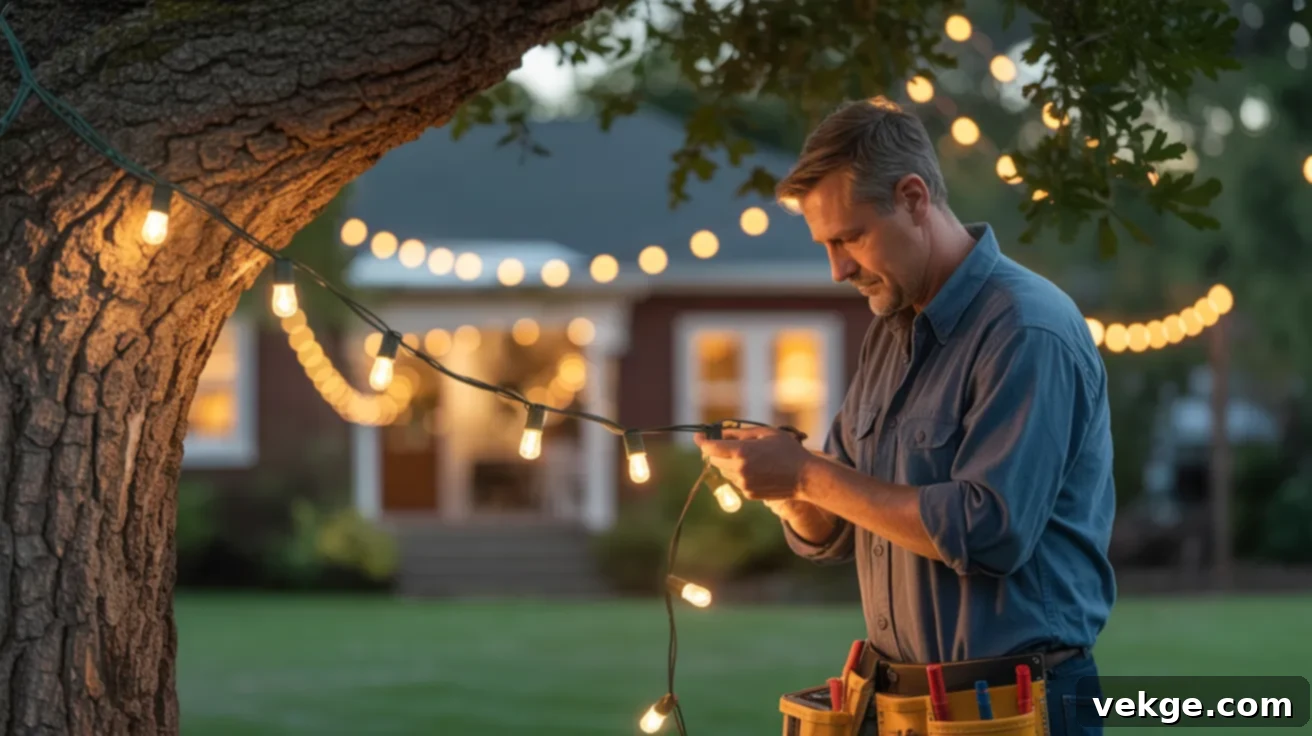
With all your string lights meticulously in place and secured, it’s time for the grand reveal! Plug in the lights and take a comprehensive walk around your yard, viewing the display from various vantage points. I make sure to observe them from the front, sides, back, and even from inside the house, noting how they impact the overall outdoor ambiance. This critical final step allows you to check for any inconsistencies: look for loose spots, uneven lines, bulbs that aren’t working, or any areas where the lights are sagging. If something looks off, it’s far easier to make adjustments now than to wait until a special event. A quick, thorough check ensures everything is safe, aesthetically pleasing, and perfectly aligned with your initial vision, guaranteeing a flawless and captivating illuminated tree.
Creative Design Ideas for Stunning Tree Lighting Displays
Tree lighting offers an incredible range of possibilities, adaptable to countless settings—from creating relaxed patio vibes and festive gatherings to crafting cozy, seasonal themes. The layout, chosen bulb type, and color scheme all play a pivotal role in shaping the overall feel and impact of your display. Below are simple yet highly effective ideas to help you bring diverse and captivating looks to life in your outdoor space, transforming ordinary trees into extraordinary illuminated features.
1. Romantic Canopy of Lights
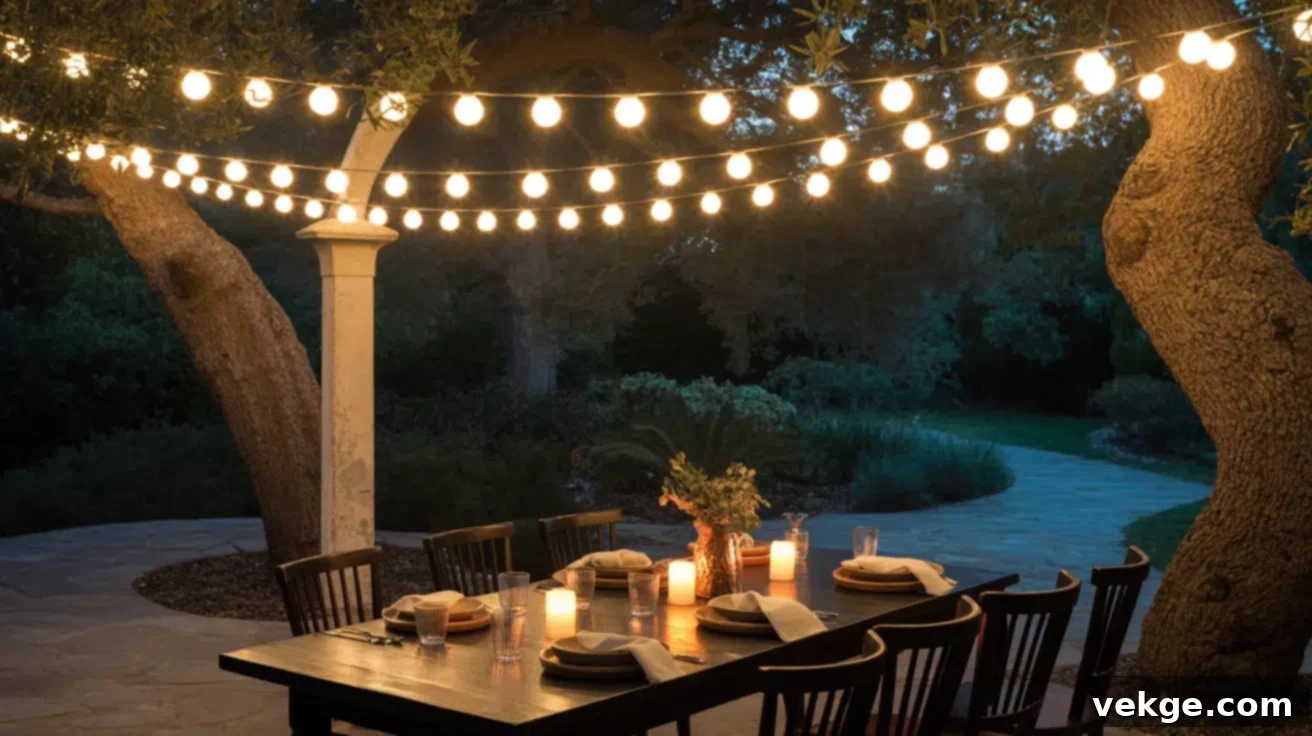
Create an enchanting overhead experience by stretching string lights from high tree branches to a central point, or to surrounding poles/structures, forming a breathtaking “ceiling” of soft, diffused light. This design is exceptionally effective for outdoor dining areas, intimate quiet evenings, or special events where a calm, balanced, and romantic glow is desired. Opt for small, warm white globe or mini bulbs, spaced evenly to produce a gentle, consistent shimmer. The canopy shape adds a wonderful sense of height and enclosure, making the space feel more defined and magical without the need for an overwhelming number of lights. Ensure the canopy is suspended high enough for comfortable passage underneath and use sturdy poles or additional support if the tree branches are not sufficiently close or strong enough to bear the full weight.
2. Holiday Tree Wrapping: A Festive Outline
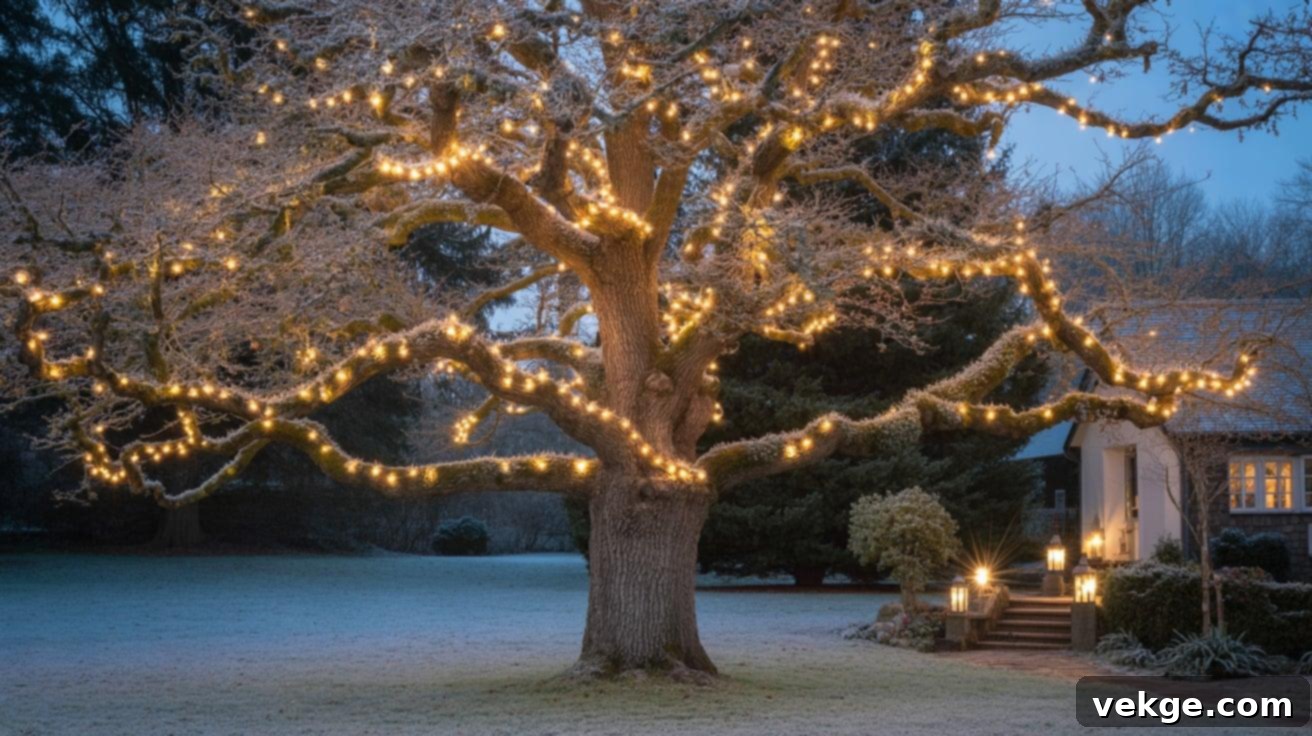
For a classic and intensely focused seasonal look, wrap string lights tightly and uniformly around the tree’s trunk and its main structural branches. This method is incredibly versatile and works beautifully on both small ornamental trees and larger, more established specimens. For winter holidays, choose traditional warm white, classic red, or vibrant green lights to evoke a festive spirit. During autumn, oranges, purples, and deep yellows can create a cozy, harvest-themed display. Maintain consistent spacing between each loop of lights to achieve a clean, polished, and professional outline that truly highlights the tree’s natural silhouette. This style adds significant brightness near the base and is perfect for illuminating entryways, garden paths, or focal points during celebratory seasons.
3. Hanging Bulb Drops: Cascading Light Effects
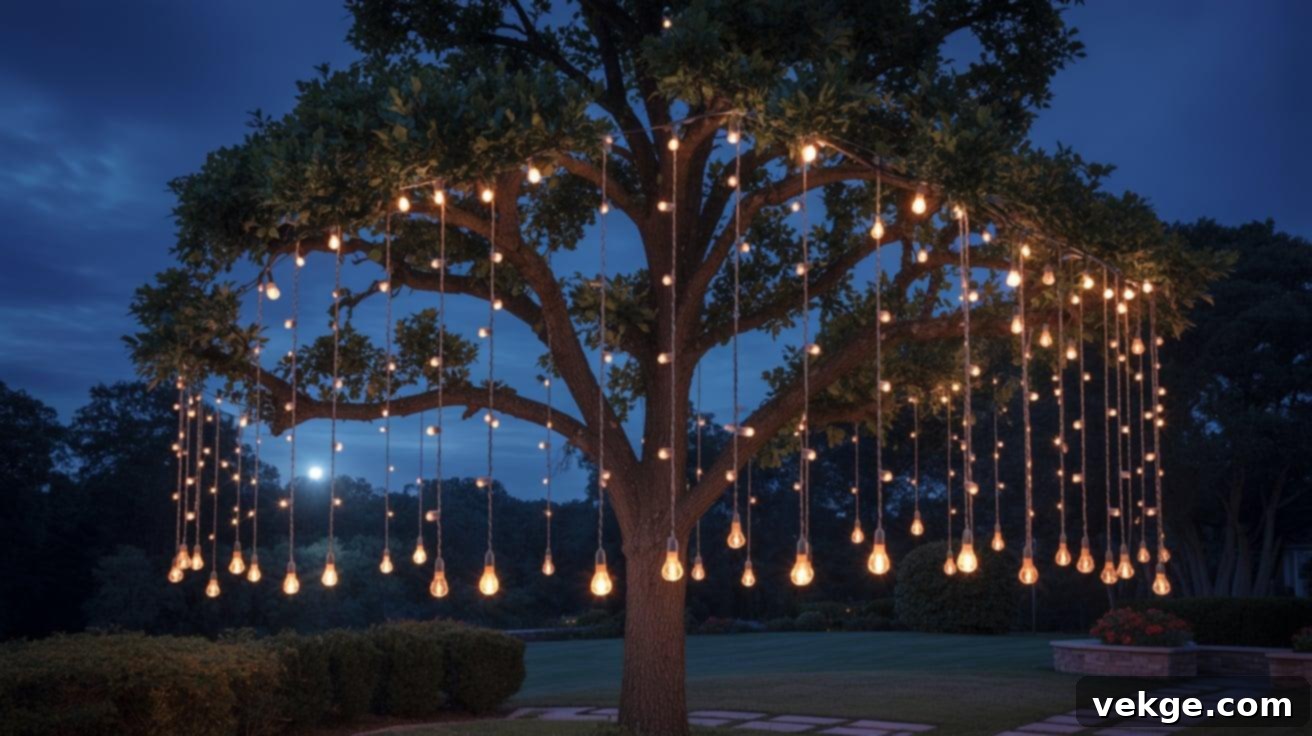
This design utilizes individual, shorter strands of lights that hang vertically downwards from higher branches, creating a captivating “drip” effect. As they sway gently in the breeze, these bulb drops produce a soft, scattered glow beneath the tree, adding a dynamic element to your lighting. Consider using larger globe bulbs or unique teardrop shapes to introduce more visual texture and character. This method is perfectly suited for casual gatherings, laid-back backyard spaces, or areas where traditional uplighting might not be feasible. To ensure a balanced appearance, space each hanging strand a few feet apart. Critically, double-check that all bulbs are facing downwards for the optimal light diffusion and a truly ethereal effect, transforming your tree into a shimmering waterfall of light.
4. Fairy Light Web: Intricate Twinkling Detail
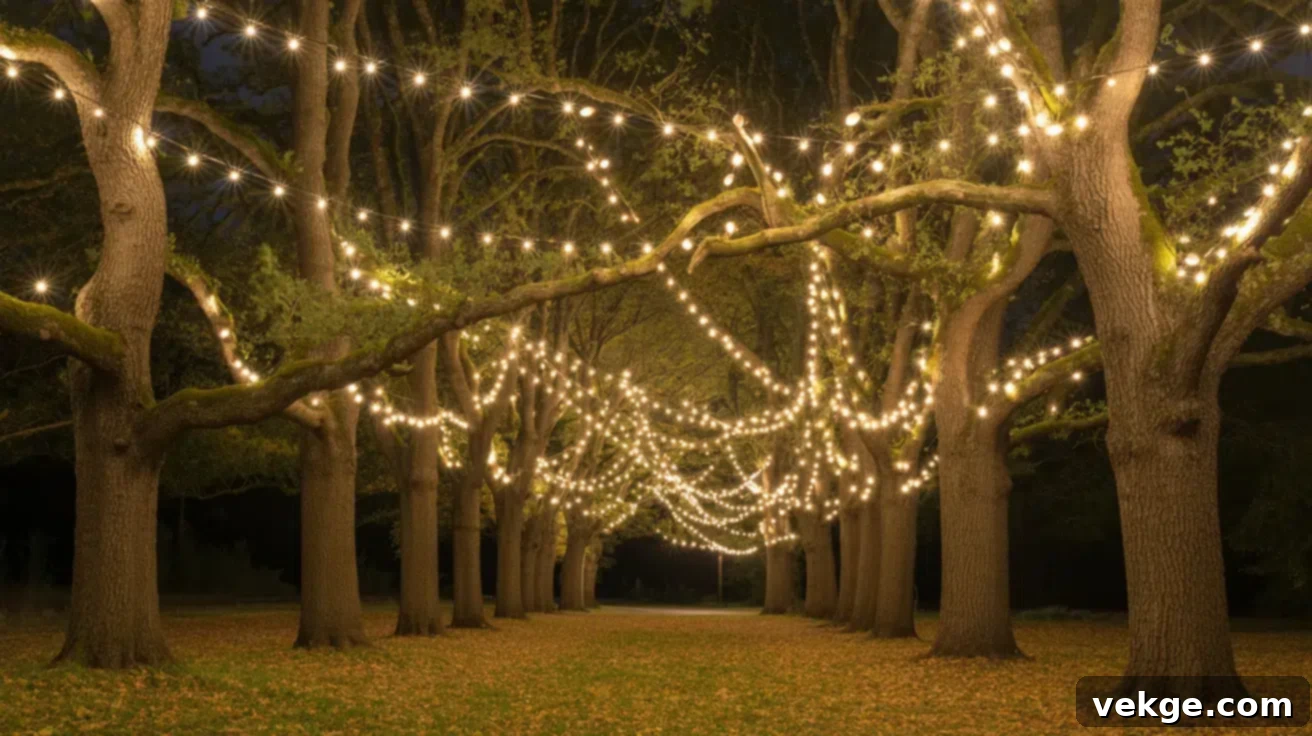
A fairy light web involves intricately running thin, delicate strands of small, often miniature, lights across multiple points within the tree’s canopy, forming a loose, net-like or interwoven structure. This technique is particularly effective when you want to illuminate several trees together, or when wrapping thinner branches from various angles to create a sense of depth. The result is a breathtaking twinkling effect that mimics starlight scattered across the tree’s surface, adding an almost magical quality to your outdoor space. Use cool or warm white fairy lights to achieve this delicate shimmer. Secure each point of the web with small, discreet clips or soft ties to hold the intricate structure firmly in place, ensuring a detailed and enchanting display that catches the eye and adds fine detail to your outdoor landscape.
5. Mixed Colors for Special Events
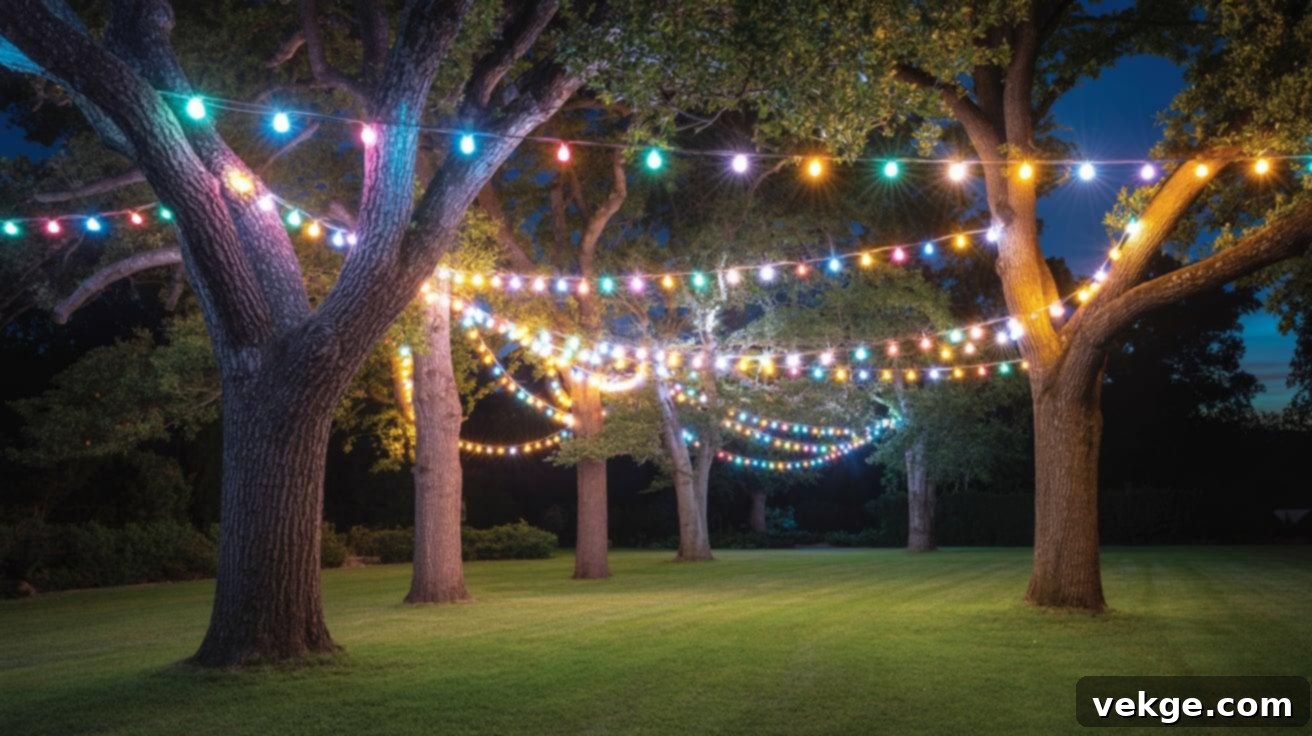
Introduce a playful or themed atmosphere to any event by incorporating colorful light strands into your tree display. The choice of colors can be tailored precisely to the occasion: think vibrant blue and white for a winter wonderland theme, soft pastels for a charming spring garden party, or a joyful assortment of multicolored strands for birthdays and casual celebrations. To achieve a balanced and harmonious look, consider combining solid-colored strands with classic warm white lights, which can temper the brightness and prevent the display from looking chaotic. These lights can be wrapped, elegantly draped, or hung vertically depending on the specific setting and desired effect. A key tip: avoid using too many distinct colors in a single area to maintain a clean, tasteful, and cohesive layout. This versatile style works exceptionally well for lively parties, cheerful outdoor seating areas, or dynamic children’s play zones, injecting personality and fun.
6. Wedding Tree Lighting: Elegant and Serene
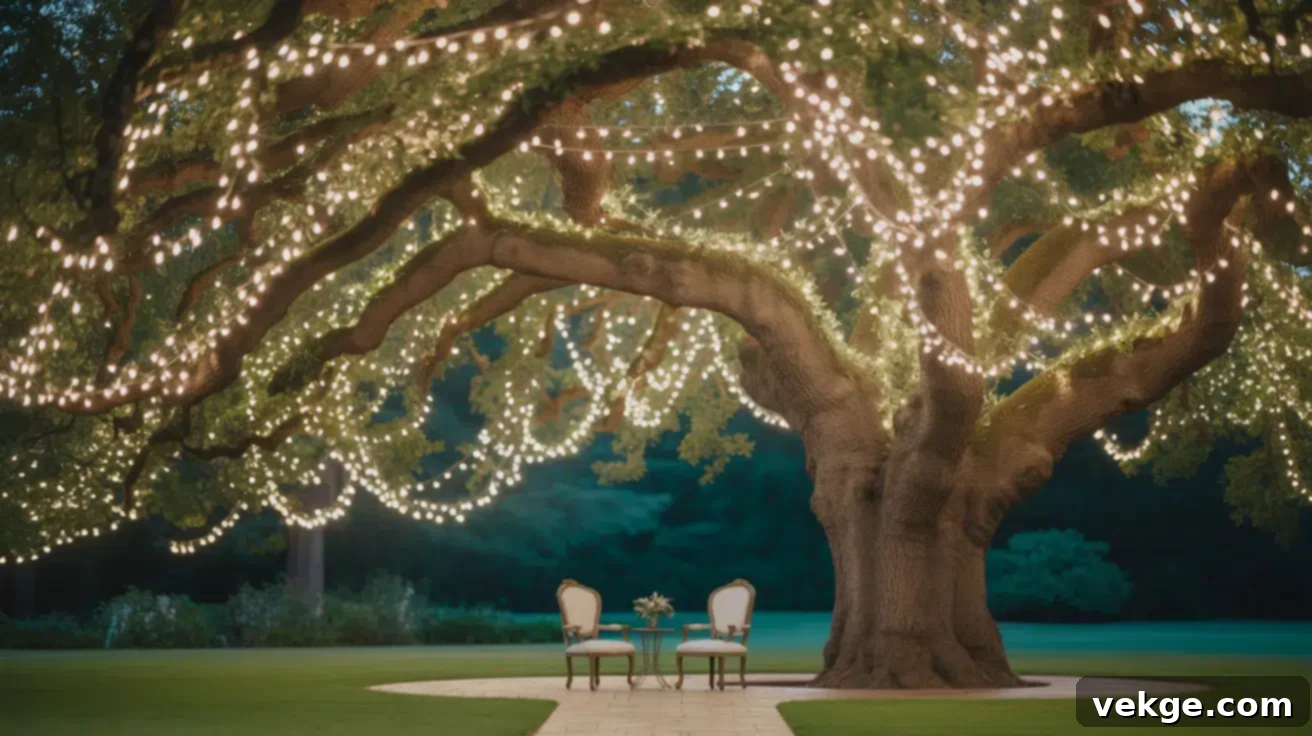
For wedding ceremonies or receptions, soft white lights are the epitome of elegance and romance. Wrapping these gentle lights around tree trunks or creating a sophisticated canopy overhead can establish a peaceful, welcoming, and utterly magical setting. You can also drape lights gracefully from higher branches to nearby poles or architectural elements to extend the overhead glow across a larger area. The key to successful wedding lighting is gentle spacing and ensuring the lights remain steady and evenly distributed. This type of setup is perfect for evening ceremonies, cocktail hours, or outdoor receptions where delicate, understated lighting adds a beautiful backdrop without detracting from the main focus of the celebration. It enhances the natural beauty of the venue, creating an unforgettable atmosphere for guests.
7. Dim Summer Nights: Casual and Relaxing
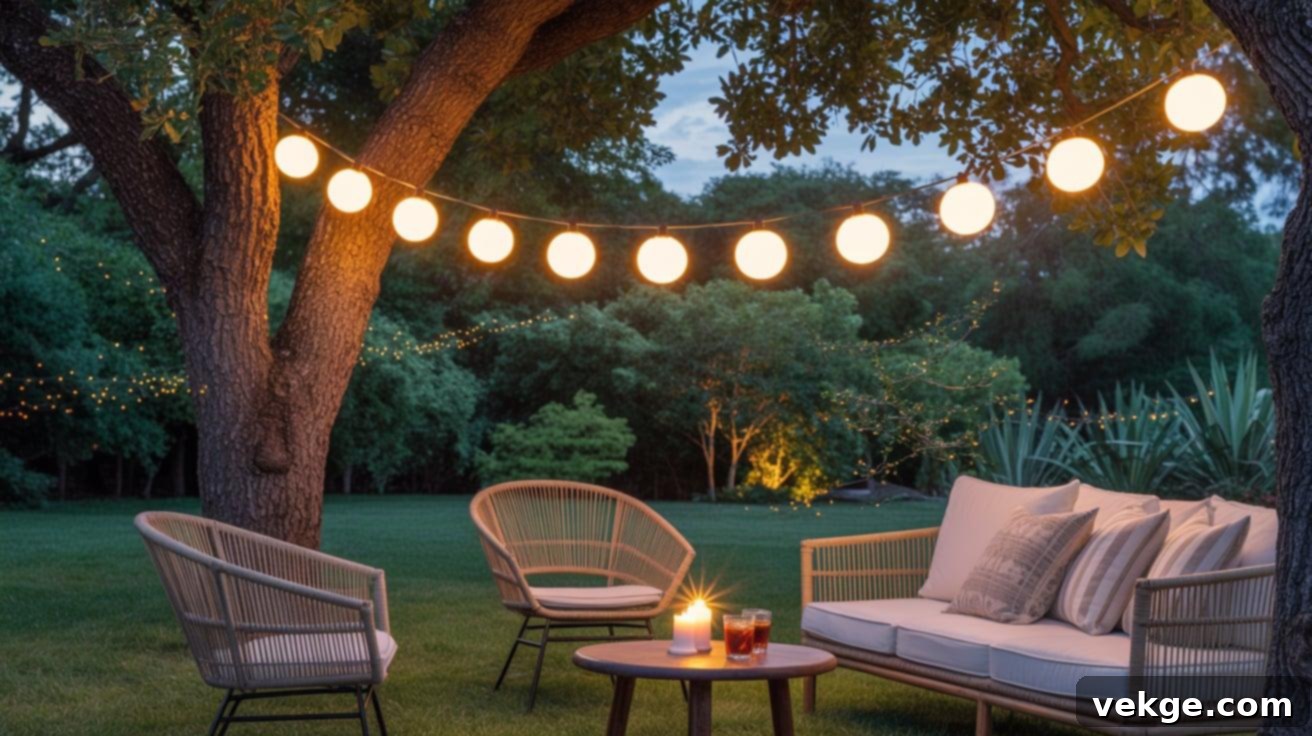
During those long, warm summer evenings, string lights are indispensable for making outdoor spaces more functional, inviting, and utterly relaxing. For a casual and laid-back ambiance, drape lights loosely between trees, or hang globe bulbs in gentle, meandering swags. I’ve found that globe-style bulbs are particularly effective for providing a wide, soft light spread that feels natural and not overpowering. To minimize the need for electrical cords and enhance flexibility, consider incorporating solar-powered string lights into your design. The primary goal here is to craft a space that is sufficiently illuminated for comfortable enjoyment and navigation, yet maintains a tranquil and cozy atmosphere, perfect for unwinding with a book, enjoying conversation, or simply soaking in the summer night air without feeling overly bright or artificial.
8. Winter & Christmas Tree Wraps: Holiday Sparkle

Embrace the festive spirit of winter and Christmas by tightly wrapping string lights around the trunks and main branches of your outdoor trees, effectively outlining their majestic shapes. Depending on your chosen holiday theme, select warm white, traditional red, or vibrant green bulbs. For a cleaner, more refined, and understated look, I often recommend using mini lights, which provide a dense, shimmering effect without chunky bulbs. This style of lighting is particularly impactful when trees are situated near entryways, driveways, or patios, serving as a beacon of holiday cheer. It not only adds essential brightness during the early sunsets of winter but also vividly brings out the seasonal color and festive atmosphere in your yard, welcoming guests with a dazzling display.
Essential Planning & Safety Tips for String Lights in Trees
Proper planning and adherence to safety guidelines are paramount when installing string lights in trees. Paying close attention to factors like spacing, light type, and the correct installation tools can prevent potential damage to your trees and lights, significantly reducing the need for frustrating repairs or replacements later on. Utilize the following comprehensive tips to guide your decisions throughout both the setup and ongoing maintenance phases, ensuring a beautiful, safe, and long-lasting display:
- **Coverage Calculation:** For a standard light coverage, plan to use approximately 100 lights for every 1 to 1.5 feet of tree height. If you desire a fuller, more dazzling effect or a denser glow, increase this ratio to 150–200 lights per foot of height.
- **Pre-Measurement is Key:** Always measure your trees and the intended light path thoroughly before purchasing or hanging lights. This prevents you from running short of lights or ending up with uneven wrapping due to miscalculation.
- **Waterproof Rating:** Critically, always choose string lights with a high waterproof rating (IP65 or higher) specifically designed for outdoor use. This ensures robust protection against rain, moisture, and dust, which are common outdoor challenges.
- **Seal Connections:** Proactively seal all plugs and connectors using weather-safe electrical tape or specialized protective covers. This crucial step creates a barrier against moisture intrusion, preventing shorts and extending the life of your connections.
- **Utilize Timers:** Invest in outdoor-rated timers to automate your lighting cycles. This not only conserves energy by ensuring lights are only on when needed but also adds convenience. Dusk-to-dawn timers are particularly effective for regular outdoor use, providing hassle-free operation.
- **Outdoor-Rated Extension Cords:** Only use heavy-duty, outdoor-rated extension cords. Before each use, meticulously inspect them for any signs of fraying, cuts, or other damage. Damaged cords pose significant electrical hazards.
- **Elevate Cords:** Keep all electrical cords off the ground whenever possible. This prevents them from sitting in puddles, being tripped over, or getting damaged by gardening equipment, thereby minimizing exposure to water and potential hazards.
- **Avoid Tight Wrapping:** Never wrap cords or light strands tightly around tree trunks or branches. This can girdle the tree, restricting its growth, causing damage to the bark, and potentially killing the branch or tree over time. Allow for ample slack.
- **Regular Inspections:** Make it a habit to regularly check all connections, anchor points, and light strands for signs of wear, sagging, shifting, or damage. Early detection allows for prompt repairs, preventing minor issues from escalating into major problems.
Smart Buying Guide: Tree String Lights That Really Shine
When you’re ready to purchase string lights, prioritize sellers who offer detailed product information and boast a history of positive customer reviews. This helps you compare quality, understand real-world performance, and confidently avoid poorly designed or unreliable products. Look for well-regarded brands like Govee, Brightech, Addlon, or Twinkle Star; these manufacturers are frequently rated highly for their durability and offer a wide range of outdoor-friendly options.
For small trees or accent lighting where a subtle sparkle is desired, **mini LED lights** are an excellent choice due to their delicate appearance and efficiency.
Recommendation: Govee LED Smart Light Bulbs (These are smart bulbs, not string lights. For string lights, recommend Govee string light products)
For more expansive areas that require broader illumination or a distinct style, **globe and Edison bulbs** are generally better suited, providing a more substantial visual presence and stronger light output.
Recommendation: Brightech Ambience Pro – Waterproof LED Outdoor String Lights
Additionally, **smart lights** (which can be controlled via apps) and **solar lights** are invaluable for minimizing manual effort and contributing to energy savings, offering modern convenience. For consistent, unwavering brightness, **plug-in models** are always the best bet.
Recommendation: Sunco 10 Pack G25 LED Light Bulbs (Again, these are individual bulbs, not string lights. It’s important to differentiate.)
Crucially, always verify that the product features appropriate weatherproof ratings, such as IP65, and UL-certified cords. This certification ensures that your setup meets safety standards for outdoor use. Lastly, confirm that the seller has a clear and fair return policy and positive customer feedback. This not only builds confidence in your purchase but also safeguards your budget in case of any issues.
How to Store and Reuse Your Tree String Lights Effectively
Once the festive season or special event concludes, taking proper care of your string lights is essential for their longevity and your convenience. Safe removal, organized storage, and creative reuse strategies will help you maximize the value of your investment year after year, ensuring your beautiful lights are ready to shine for many seasons to come.
How to Remove Lights Without Damage: A Gentle Approach
Before you begin the removal process, always ensure all lights are unplugged from their power source to prevent any electrical hazards. Start removing the lights from the end of the strand, working your way systematically back towards the plug. This method significantly reduces the likelihood of tangling, which can be a major headache later. Gently loosen any zip ties, clips, or ties you used, being careful to avoid pulling directly on the wire itself, as this can damage the internal components or connections. Utilize a sturdy ladder whenever necessary to reach higher sections safely, preventing strain or accidental falls. As you remove each bulb, quickly check it for any cracks, chips, or signs of wear. Careful handling during the removal process is a small effort that pays off immensely, helping your lights last much longer, reducing waste, and preventing costly replacements.
Off-Season Storage Tips: Keep Them Organized and Protected
Effective storage is key to preserving your string lights. To prevent frustrating knots and tangles, loosely wrap the light strands around a dedicated light reel, a sturdy piece of cardboard, or a plastic hanger. Avoid tight winding, which can stress the wires. Place the neatly wrapped lights in labeled bins or boxes. To combat moisture and prevent rust or corrosion, consider adding moisture-absorbing packets (like silica gel) to your storage containers. Ensure that individual bulbs are facing outward and untwisted to protect them from pressure. Store these containers in a dry, cool, and dark space, away from direct sunlight, which can degrade plastic components over time. Organized storage not only saves you immense time and frustration when the next season arrives but also keeps all parts in excellent condition, ready for immediate reuse.
Reusing Lights for Other Projects: Year-Round Illumination
Don’t let your beautiful string lights sit idle for most of the year! Extra or unused strands can find new life and purpose in other areas of your home, extending their decorative value. Consider incorporating them into indoor spaces: they can add a cozy glow to bedrooms, illuminate wall shelves, or serve as charming accents on patios and balconies during non-holiday seasons. Get creative by wrapping lights around mirrors, draping them over curtain rods, tucking them inside clear glass vases, or arranging them within decorative jars for unique indoor lighting features. This approach ensures your lights are utilized year-round, preventing perfectly good items from gathering dust. With basic care and imaginative reuse, the same string lights can brighten multiple spaces and occasions, providing continuous ambiance and joy throughout the year.
Remember, proper removal, diligent storage, and creative reuse not only protect your investment in string lights but also contribute to cost savings and significantly reduce your setup time in future seasons, making seasonal decorating a breeze.
Final Thoughts on Illuminating Your Trees
Through my experience, I’ve consistently found that adding string lights to trees is one of the most effective and rewarding ways to infuse a yard with warmth, charm, and a truly special ambiance. Now that you’re equipped with comprehensive knowledge—from selecting the ideal lights and installing them safely without harming your trees, to mastering various styling techniques for any season or event—you have all the tools to replicate that inviting and cozy vibe in your very own outdoor space.
I encourage you to take a moment, step outside, and observe your trees with a fresh perspective. Envision the different setups and styles that would best complement your existing landscape and personal taste. Whether you’re planning an intimate, quiet evening under the stars or preparing for a lively gathering with friends and family, you now possess the expertise to light up your outdoor areas beautifully and safely. Just remember the importance of periodic checks to ensure your lights remain secure and functional.
If this guide has sparked your imagination and provided valuable insights, please continue exploring our blog for even more inspiring outdoor ideas, practical tips, and creative ways to enhance your living spaces. Happy lighting!
Frequently Asked Questions About Tree String Lights
Do string lights use a lot of electricity?
The electricity consumption of string lights varies significantly depending on the bulb type. Modern LED string lights are incredibly energy-efficient, using a fraction of the electricity compared to older incandescent versions. This makes them a highly cost-effective choice for both long-term and daily outdoor use. Pairing them with a timer can further optimize energy savings by ensuring they only illuminate when needed, reducing their environmental footprint and your utility bills.
How do I fix a section of lights that stops working?
If a section of your string lights unexpectedly goes out, don’t panic! Start by checking the fuse located within the plug; often, a blown fuse is the culprit and is simple to replace. Next, systematically inspect each bulb in the affected section for any signs of damage or a loose connection. Replace any broken, missing, or loosely seated bulbs, as one faulty bulb can sometimes cause a whole section to fail in older series-wired strands. If these steps don’t resolve the issue and the entire strand remains unlit, it might indicate a more complex internal wiring problem, and in such cases, replacing the entire strand might be the most practical solution.
Are solar string lights bright enough for evening gatherings?
Solar string lights are excellent for providing a soft, ambient glow, perfect for creating a relaxed atmosphere during evening gatherings. However, their overall brightness and duration depend heavily on several factors: the quality of the solar panel, the efficiency of the integrated battery, and the amount of direct sunlight they receive throughout the day for charging. For situations requiring brighter, more consistent illumination, such as larger events or where ample light is crucial, look for higher-quality solar lights equipped with larger capacity solar panels and robust battery life. Alternatively, augmenting solar lights with plug-in strands can provide the best of both worlds: ambient glow with reliable brightness.
